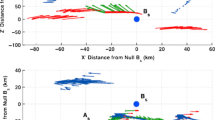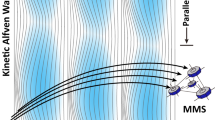Abstract
The goal of mission-oriented theory is to develop techniques and models which can be used by experimentalists and theorists to interpret spacecraft measurements, deducing from them the maximum amount of information about both local and large-scale dynamics. To be effective, theorists and experimentalists must express their results in a common format. A reasonable starting point is for mission theorists to adopt the format currently used by experimentalists. To this end we have developed new diagnostics for plasma kinetic simulations, which display the results in formats very similar to those commonly used to present satellite wave and particle measurements. We have used a simulation of broadband electrostatic noise to demonstrate how, by comparing simulation results with observations, we can infer quantities which cannot be measured, such as the wave mode. We are also developing the capability of creating data streams from virtual spacecraft located in the simulation region. For example, we used a kinetic magnetopause simulation to explore the ways in which simulations can assist in the interpretation of single and multiple satellite measurements in regions of strong spatial inhomogeneity. To address directly the mission objective of measuring global transport, global MHD models are employed. In order to facilitate the initial comparison with ISTP satellites, time histories of simulated generic states of the magnetosphere will be stored on optical disks; these will then be used to create dynamical displays of both local parameters and the global configuration. Finally we demonstrate the use of data based phenomenological magnetic field models in single particle trajectory calculations to describe large-scale kinetic properties of the magnetospheric plasma. We briefly discuss the success of large-scale kinetic calculations in delineating the structure of the plasma sheet, and present some possible ISTP research initiatives which can be used to determine the structure of the very distant tail and the entry of plasma into the tail.
Similar content being viewed by others
References
Ashour-Abdalla, M., Berchem, J., Büchner, J., and Zelenyi, L. M.: 1991,Geophys. Res. Letters 18, 1603.
Ashour-Abdalla, M., Berchem, J., Büchner, J., and Zelenyi, L. M.: 1993,J. Geophys. Res. 98, 5661.
Axford, W. I. and Hines, C. O.: 1961,Can. J. Phys. 39, 1433.
Berchem, J., Schriver, D., and Ashour-Abdalla, M.: 1991,Geophys. Res. Letters 18, 729.
Berchem, J., Raeder, J., and Ashour-Abdalla, M.: 1993,Proc. Spatio-Temporal Analysis for Resolving Plasma Turbulence (START) Conference, ESA SP-047, p. 393.
Bosqued, J. M., Ashour-Abdalla, M., El Alaoui, M., Peroomian, V., Zelenyi, L. M., and Escoubet, C. P.: 1993,J. Geophys. Res. 98, 19,181.
Dungey, J. W.: 1961,Phys. Res. Letters 6, 47.
Fedder, J. A. and Lyons, J. G.: 1987,Geophys. Res. Letters 14, 880.
Lin, R. P. and Anderson, K. A.: 1966,J. Geophys. Res. 71, 4213.
Moore, T. E.: 1984,Rev. Geophys. Space Phys. 22, 264.
Ogino, T.: 1986,J. Geophys. Res. 91, 6791.
Ogino, T., Walker, R. J., and Ashour-Abdalla, M.: 1992,IEEE Trans. Plasma Sci. 20(6), 817.
Raeder, J., Walker, R. J., and Ashour-Abdalla, M.: 1993,Geophys. Res. Letters, submitted.
Russell, C. T. and Elphic, R. C.: 1979,Geophys. Res. Letters 6, 33.
Schriver, D. and Ashour-Abdalla, M.: 1990,J. Geophys. Res. 95, 3987.
Schriver, D. and Ashour-Abdalla, M.: 1991,Geophys. Res. Letters 18, 1607.
Siscoe, G. L., Scarf, F. L., Intriligator, D. S., Wolfe, J. H., Binsack, J. H., Bridge, H. S., and Vasyliunas, V. M.: 1970,J. Geophys. Res. 75, 5319.
Siscoe, G. L. and Sanchez, E. L.: 1987,J. Geophys. Res. 92, 7405.
Tsyganenko, N. A.: 1989,Planetary Space Sci. 37, 5.
Walker, R. J., Ogino, T., Raeder, J., and Ashour-Abdalla, M.: 1993a,J. Geophys. Res. 98, 17,236.
Walker, R. J., Ogino, T., and Ashour-Abdalla, M.: 1993b,Proceedings of the Initial Results from STEP Facilities and Theory Campaigns.
Williams, D. J., Roelof, E. C., and Mitchell, D. G.: 1992,Rev. Geophys. 30, 183.
Author information
Authors and Affiliations
Rights and permissions
About this article
Cite this article
Ashour-Abdalla, M., Berchem, J., Coroniti, F.V. et al. Mission-oriented theory for ISTP. Space Sci Rev 71, 647–669 (1995). https://doi.org/10.1007/BF00751345
Received:
Issue Date:
DOI: https://doi.org/10.1007/BF00751345




